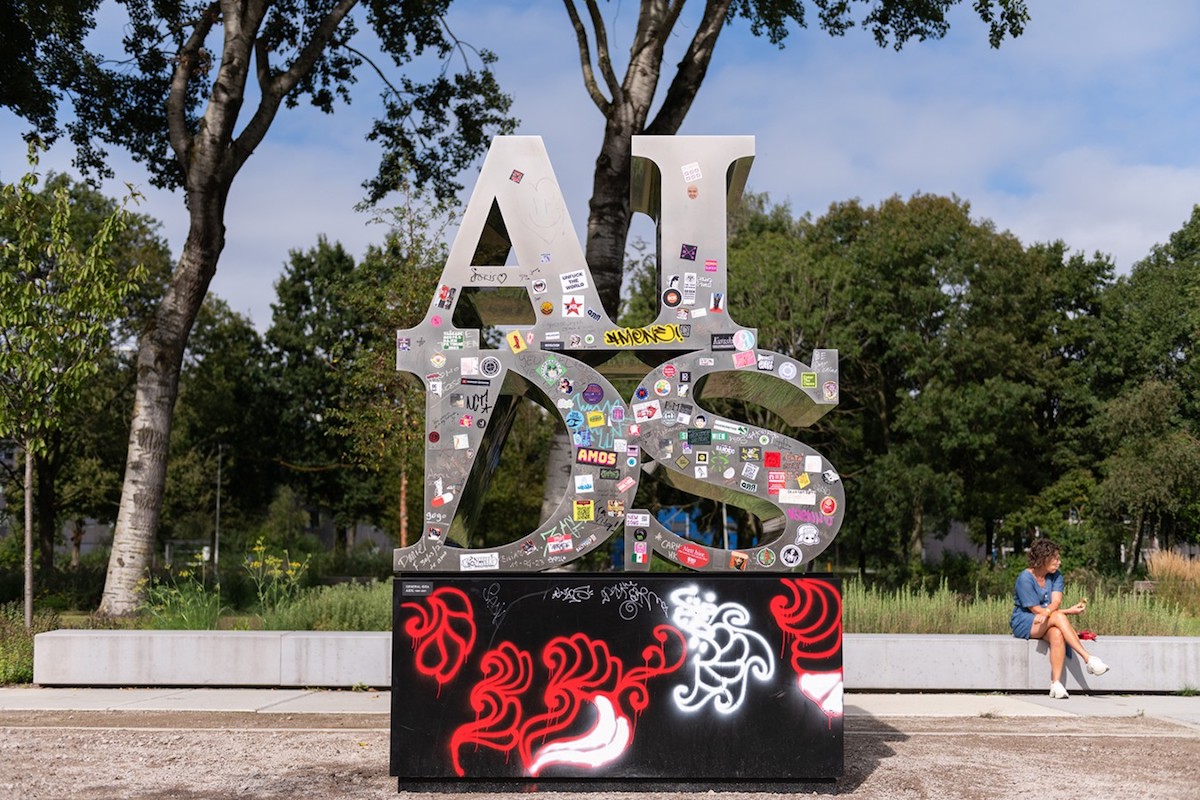Juego de Banderas
2016 - Painting (Painting)
Antonio Caro
Juego de Banderas (a play on words that loosely translates to both set of flags and game of flags) is a triptych of modified Colombian flags by Antonio Caro. Although the yellow, blue and red stripes on the first flag are faithful to the original, the second flag at the center has been modified to feature the word Colombia, emulating the typography and white-on-red design of the iconic Coca-Cola brand. Caro’s first version of this logo was a 1976 graphite drawing, and he has since produced several variations in different materials. Equally relevant now as it was in the 70s, the logo juxtaposes the idea of national identity with the process of intrusion of a foreign commercial emblem and problematizes the growing consumerism brought forth by the economic and cultural americanization experienced in Colombia and all across Latin America. A third flag on the right shows a related but different modification: the yellow stripe that symbolizes gold and the country’s riches and wealth has been rendered in black, and the only yellow remaining is used to spell out the word ‘mineria’ (mining). As per several of his works, Juego de Banderas employs symbolic elements in order to instigate a civic dialogue around issues Caro perceives around him.
One of the founders of the Conceptual Art Movement in Colombia, Antonio Caro’s idea-based works are rooted in the social issues of his country. He began showing work in the late 60s in Bogota and subsequently became an important figure in the global artistic scene, developing in over five decades a distinctive, humorous, and highly idiosyncratic visual language with an emphasis on text and other graphic elements. Some of his best known works appropriate and misuse the typography of iconic international advertising brands—such as Coca-Cola and Marlboro—as means to comment of the social and political conditions of his native Colombia and their relationship to the imperialist and capitalist hierarchies of power that now grip their reality. Although he initially gained notoriety as a conceptual artist, over the years his practice has resisted categorizations, easy commercialization—through his choice of materials such as salt, achiote, cardboard and paper scraps—and has consistently questioned the label of ‘political art’ through his distinctive use of sarcasm, wit, and critical sense of humor.
Colors:
Related works of genres: » conceptual art, » contemporary artist, » conceptualization, » contemporary painters, » painter, » born 1950

© » KADIST
Keith Tyson
The work of Keith Tyson is concerned with an interest in generative systems, and embraces the complexity and interconnectedness of existence...

© » KADIST
Paul McCarthy
2008Memory Mistake of the Eldridge Cleaver Pants was created for the show Paul McCarthy’s Low Life Slow Life Part 1 , held at California College of the Arts’s Wattis Institute in 2008 and curated by McCarthy himself...

© » KADIST
John Baldessari
1991The voids in Baldessari’s painted photographs are simultaneously positive and negative spaces, both additive and subtractive...

© » KADIST
Mark Bradford
2012This untitled work from 2012 is a print originally made as part of the Wattis Institute for Contemporary Art’s artist limited edition series...

© » KADIST
Gabriel Orozco
1992Gabriel Orozco often documents found situations in the natural or urban landscape...

© » KADIST
Paul McCarthy
1983McCarthy’s Mother Pig performance at Shushi Gallery in 1983 was the first time he used a set, a practice which came to characterize his later works...

© » KADIST
Allan McCollum
1982In the work titled The Glossies (1980), an affinity for photography manifested itself before McCollum actually began to use photography as a medium...

© » KADIST
Kara Walker
2005In her masterpiece 8 Possible Beginnings or The Creation of African-America , Walker unravels just that, the story of struggle, oppression, escape and the complexities of power dynamics in the history following slave trade in America...

© » KADIST
Raymond Pettibon
2000Untitled (Wall Street’s Chosen Few…) is typical of Pettibon’s drawings in which fragments of text and image are united, but yet gaps remain in their signification...

© » KADIST
Sebastián Díaz Morales
2014In Suspension a young man is hanging in the air, falling, or perhaps drifting through time and space...

© » KADIST
Laure Prouvost
2017The Parle Ment Metal Woman Welcoming You is a character originated from a series of works combining sculpture and video with a specific role— lying on the floor playing a romantic elevator tune, this Metal Woman welcomes and flirts with viewers in the space where she is posed...

© » KADIST
Harun Farocki
2009For Immersion , Harun Farocki went to visit a research centre near Seattle specialized in the development of virtual realities and computer simulations...

© » KADIST
Laure Prouvost
2010In Stong Sory Vegetables , Laure Prouvost explains that she woke up one morning and that some vegetables had fallen from the sky on her bed, making a hole in her ceiling...

© » KADIST
Hank Willis Thomas
2014Shot in black and white and printed on a glittery carborundum surface, Black Hands, White Cotton both confronts and abstracts the subject of its title...

© » ARTLYST
General Idea
Following its display at the General Idea retrospective in Stedelijk Museum Amsterdam The post AIDS Sculpture By General Idea Finds Permanent Home In Amsterdam Park appeared first on Artlyst ....





